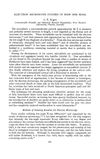A Study of the Differentiation Products of the Hair Follicle Cells with the Electron Microscope
July 1964
in “
PubMed
”
TLDR Hair follicle cells become four types: medulla, cortex, cuticle, and inner root sheath.
The study from 1964 used an electron microscope to examine the differentiation of hair follicle cells. It found that undifferentiated matrix cells at the base of the follicle differentiate into four cell types: medulla, cortex, cuticle, and inner root sheath. Medulla cells develop granules, cortex cells form cytoplasmic fibers, cuticle cells flatten and hyalinize, and inner root sheath cells form trichohyalin granules that later turn into fibrous material. The inner root sheath cells are eventually lost by scaling and do not contribute to the hair fiber.

